
EARTHQUAKES AND ASTROLOGICAL INDICATORS
By Didem Can
August 2025
Abstract
Throughout history, questions surrounding the causes and mechanisms of earthquakes have gradually evolved alongside scientific and technological advancements. While early inquiries focused on “why” and “how,” contemporary approaches increasingly center on the question of “when.” Nevertheless, the precise prediction of earthquakes remains a significant scientific challenge due to factors such as the inaccessibility of the Earth’s deep interior, the complex structure of fault systems, and the inconsistent occurrence of precursor tremors.
The primary objective of this study is to investigate potential correlations between seismic events and planetary configurations from an astrological perspective. The analysis encompasses planetary positions, angular relationships (aspects), zodiacal placements, aspect patterns, lunar phases, and midpoint structures. Beyond the classical planetary bodies, the study also considers fixed stars, trans-Neptunian points (TNPs), critical degrees, asteroids, and their combinatory influences. In instances where the exact timing of seismic events is available, the Ascendant (ASC) and Midheaven (MC) axes are incorporated into the evaluation. The sample group consists of 1687 earthquake charts.
The Sources
Historical Perceptions and Philosophical Interpretations of Earthquakes
Throughout history, earthquakes have been natural phenomena that have both terrified and intrigued humankind. In ancient times, these mysterious tremors sparked curiosity about their causes and mechanisms—questions that, for the most part, remained unanswered. Consequently, in early periods, earthquakes were often simply interpreted as manifestations of divine wrath. Historical texts indicate that following each major tremor, various prayers, rituals, and magical practices were developed in an attempt to pacify this perceived divine anger (1).
While ancient perceptions of earthquakes were deeply rooted in religious beliefs, over time these interpretations gradually gave way to more scientific explanations. In Sumerian belief, earthquakes were considered a form of divine punishment directed at humanity. The deity responsible for these tremors was EA (later known as Enki), the god of subterranean waters and seas. This deity was later associated with Poseidon from the Greek pantheon, the god believed to stir the seas and cause earthquakes (Kramer, 1999).
Poseidon was said to create earthquakes by striking the ground with his trident. For this reason, he was also referred to as Enosigaios, meaning "Earth-shaker" (2).
As history progressed, religious interpretations began to be challenged by philosophical reasoning. Among the earliest Greek philosophers, Thales is regarded as the first to abandon mythological narratives in favor of natural philosophy in explaining the world. Thales proposed that all matter derived from a single fundamental substance, which he believed to be water. This theory had a significant influence on subsequent thinkers of his era.
Thales posited that the Earth floated upon water, much like a ship. According to him, earthquakes occurred when the water beneath the Earth shifted or moved (3). Known for correctly predicting the solar eclipse on May 28, 585 BCE, Thales’s most enduring legacy is arguably his rational method of inquiry.
However, not all philosophers accepted his views. The Roman philosopher Seneca, for instance, later dismissed Thales’s theory as implausible (4).
Anaximander, a student of Thales, proposed that the Earth was shaped like a drum and that it cracked under its own weight, thereby causing earthquakes (5). Another Milesian philosopher, Anaximenes, also attempted to explain earthquakes through reason. His theory is considered one of the earliest models of seismic activity in history. He was even believed to have predicted an earthquake in Sparta.
Anaximenes theorized that earthquakes occurred when the earth, whether moist or dry, cracked after heavy rainfall. He asserted that during dry or excessively rainy periods, the earth would break apart due to internal pressure. Rain would fill the hollow spaces within the Earth, and once the rainy season ended, heat would dry the surface, leading to fissures and, subsequently, seismic activity (6)(7).
Aristotle, on the other hand, suggested that moisture and dryness within the soil generated vapors, and that earthquakes were the result of these vapors accumulating and being violently released. He noted that earthquakes typically occurred during spring and autumn, periods characterized by transitions between wet and dry conditions. He also observed, albeit rarely, a temporal correlation between earthquakes and lunar eclipses (8).
Ptolemy, in his work Tetrabiblos, offered astrological classifications related to earthquakes. For instance:
Taurus in its entirety shows both heat qualities and is moderately warm. However, the early degrees near the Pleiades cluster are particularly associated with earthquakes, winds, and fog.
Gemini produces a moderate climate overall, but its early degrees are rainy and destructive; the middle degrees are temperate, and the final ones are chaotic and unstable. Its northern regions are linked with wind and earthquakes; the southern parts are dry and arid.
Cancer, in general, signifies pleasant, warm weather, but the early parts and the Praesepe cluster are sultry, seismic, and misty. The middle degrees are temperate, while the later degrees are windy. Northern and southern regions are hot and scorching.
Scorpio is marked by thunder and fire; its early degrees are snowy, the middle temperate, and the latter parts are associated with earthquakes. The northern parts are hot, and the southern humid. (9)
In the same work, Ptolemy also suggested that conjunctions or interactions between Saturn and Mars in Earth signs could trigger earthquakes:
"Saturn and Mars, if controlling the luminaries, and especially if placed distant from each other, will produce great dangers… and if in terrestrial signs, by the attack of wild beasts, or from earthquakes..." (10)
The rational inquiry initiated by Thales—often regarded as the founder of natural philosophy—continues to inspire investigations into the causes of earthquakes. In more recent times, following the discovery of Uranus, the planet has been associated with destructive, unexpected, and disruptive events, including earthquakes. Some studies emphasize that the planet often appears near meridian points at the time of seismic events (11).
METHODOLOGY
Based on the aforementioned framework, this study aims to identify significant astrological indicators present during seismic events and to investigate whether there is a meaningful correlation between planetary influences—specifically Uranus, Neptune, Poseidon (TNP), Saturn, Mars—and the occurrence of earthquakes.
Data Sample
The study was conducted on a dataset comprising 1,687 earthquakes with a magnitude of 6.0 or higher. The temporal distribution of the dataset spans from the 1293 Kamakura Earthquake to the March 22, 2025 Philippines Earthquake. The distribution by period is as follows.

Historical earthquake data were primarily obtained from the USGS (United States Geological Survey – Science for a Changing World) database, while older earthquake records were compiled from Wikipedia. Since Wikipedia provides local time data, these times were used as-is. However, USGS data—recorded in UTC—were converted to local time and recorded using Sirius 3.0 software.
Due to the availability of time and location information, ASC (Ascendant) and MC (Midheaven) were included in the data analysis. These were specifically considered for their potential triggering effects, particularly those involving fast-moving celestial bodies.
Aspects
In addition to the major aspects, this study included 135° and 45° aspects, analyzed with a 5-degree orb. The following aspects were considered:
Fixed Stars
The frequency of fixed stars in conjunction with planets (within a 2° orb) was examined.
Zodiacal Signs
The zodiacal placements of planets at the time of each earthquake were analyzed for frequency and pattern recognition.
OOB (Out-of-Bounds) Planets
Each event chart was evaluated to determine which planets were out-of-bounds (OOB) at the time of the seismic event.
Critical Degrees
The study analyzed which critical degrees were activated by conjunctions, as well as which planets were aspecting these degrees.
Critical degrees used in this research:
While the precise origins of these critical degrees remain uncertain within the classical or Hellenistic tradition, both Ibn Ezra and Vettius Valens mention the specific qualities of certain degrees in their works.
For instance, Ibn Ezra states that 6°, 11°, 17°, and 23° of Aries reduce fortune (11). Valens describes 0° Aries as stormy, hail-filled, windy, and destructive (12), and the first three degrees of Gemini as unstable and of little value. Neither Ezra nor Valens classify these degrees by modality (cardinal/fixed/mutable).
Among these degrees, the vernal equinox at 0° Aries, also known as the Aries Point, marks the intersection of the celestial equator and the ecliptic and is frequently used in the analysis of terrestrial phenomena.
Asteroids, TNPs, Nodes, Angles (MC–ASC), Vertex & East Point
The following additional astrological points were included in the analysis with a 5° orb:
TNP aspects and midpoints were also analyzed a second time within a 30' orb, to test the broader influence range. The same ranking was obtained in the study conducted for both orbs.
Midpoints
Midpoints between all planets, asteroids, nodes, and angles were evaluated using a 5° orb.
Aspect Patterns
Major aspect configurations were examined, including:
FINDINGS
Astrological Distribution Patterns in Relation to Planetary and Celestial Bodies
This study investigates the distribution of celestial bodies across various astrological parameters, including elemental and sign placements of planets, the influence of Trans-Neptunian Objects (TNOs), asteroid interactions, angular relationships, lunar phases, midpoints, fixed stars, and out-of-bounds planets. The analysis aims to identify significant astrological correlations within a given dataset, particularly in the context of specific natural phenomena.
Planetary and Astroid Distribution in Zodiac Signs
Upon examining the elemental distribution of planets, "earth" elements appear to be prominent. Concurrently, within the zodiac sign distribution of planets, Capricorn and Pisces emerge as particularly significant (Graph 1).
.jpg)
Further detailed analysis indicates that Saturn and Jupiter are frequently positioned in their respective ruling signs (Table 1).
.jpg)
The robustness of these findings was confirmed through testing across different groups, yielding statistically significant results (Table 2).

Similarly, an examination of asteroids within their own group reveals a predominance of Capricorn and Pisces, akin to the planetary distribution. Additionally, Sagittarius also showing a notable prominence. However, no significant distinction was observed in the house distribution of planets.
Planets and TNP's in Aspects
To understand the interactions between planets and hypothetical celestial bodies, it is essential to define Trans-Neptunian Objects (TNOs). Alfred Witte, a German astrologer and mathematician and the founder of Uranian Astrology, observed artillery fire timings during World War I (1919-1925, with his first observations in 1913). He concluded that known astrological techniques did not align with these precise timings. Witte postulated the existence of energy fields in the sky that move similarly to other planets but do not correspond to any known celestial bodies. These points are believed to house undiscovered planets and are referred to as TNOs or "Trans-Neptunian Objects." Subsequently, they have been termed Trans-Neptunian Objects, Trans-Neptunian Planets, or Hypothetical Planets. These include: Cupido, Hades, Zeus, Kronos, Apollon, Admetos, Vulcanos, and Poseidon. The first four were identified by Witte, and the latter four by Friedrich Sieggnum.
In light of this information, the aspects formed between planets themselves and between planets and TNOs were analyzed.
Regarding the aspects between planets, notable interactions include those between Neptune and Uranus, and Neptune and Pluto. Saturn also stands out as a prominent planet in these aspect relationships (Graph 2).
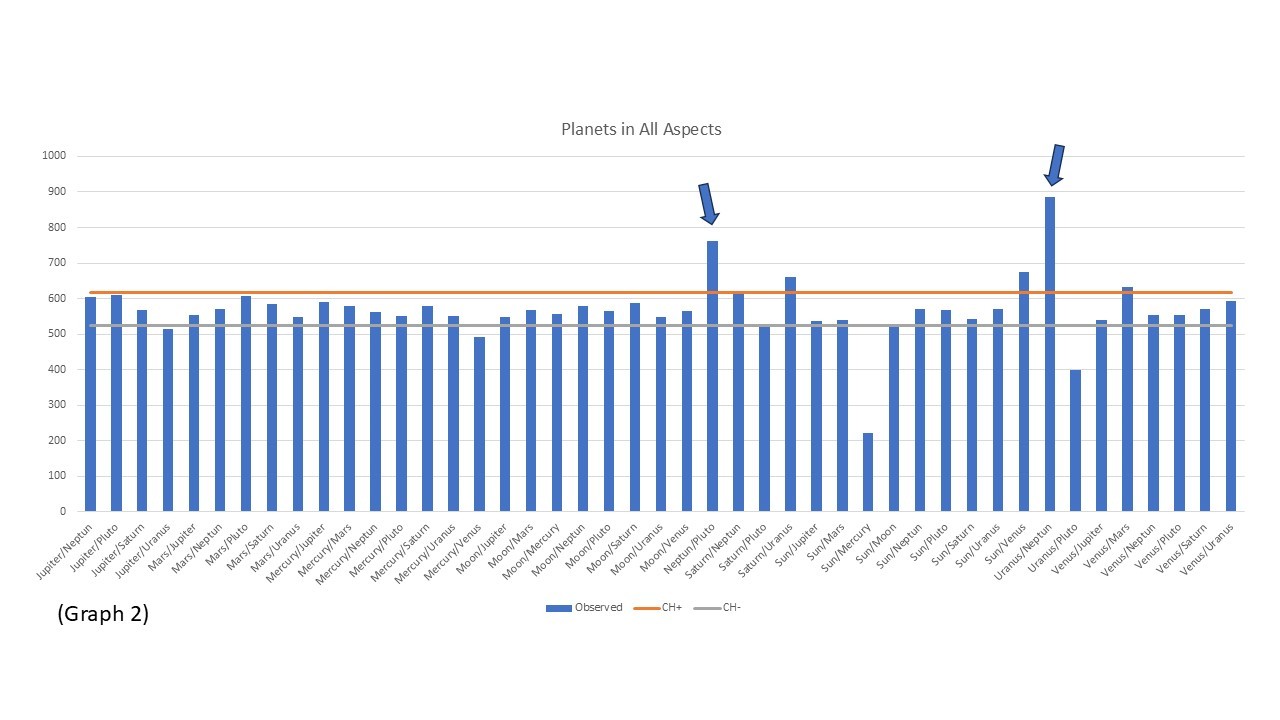
As observed in Graph 2, t-tests conducted on the aspects of Neptune/Pluto, Neptune/Uranus, Sun/Venus, and Saturn/Uranus pairs across different groups yielded statistically significant results (Table 3).
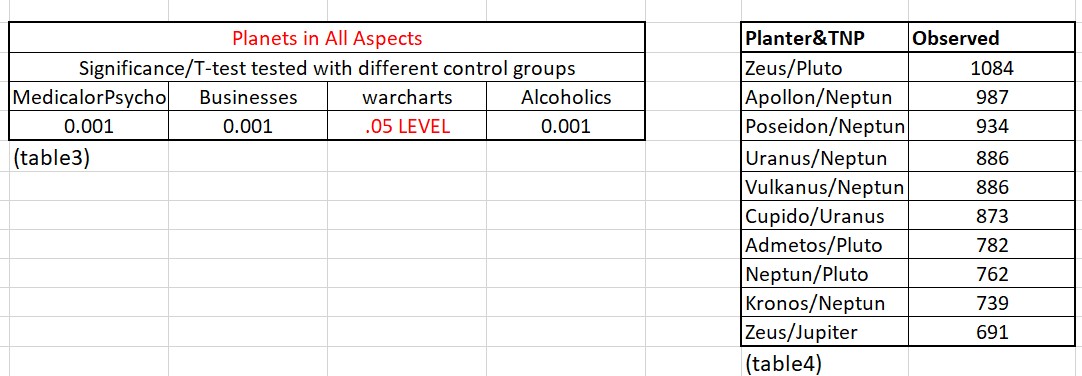
When examining the aspects between TNOs and all planets, the Zeus/Pluto aspects are distinctly prominent, followed by the Apollon/Neptune pairing (Table 4).
In Uranian astrology, Zeus is symbolized by an energy similar to that of Mars and Uranus, characterized by goal-oriented drive and dynamic force. It represents well-organized action, fire, weaponry, fertilization, and the momentum that propels a process forward. The Pluto/Zeus combination may signify the initiation of a new phase or the sudden alteration of prevailing conditions.
Apollon, on the other hand, is associated with Jupiterian energy and is traditionally linked with the sign of Gemini. It contributes a principle of multiplicity to any configuration it engages with, and is associated with science, commerce, and intellectual pursuits. Apollon signifies processes of expansion, amplification, and development. In the context of a seismic event, the expansive influence of Apollon may serve to intensify the manifestation of fear, devastation, and loss, rendering the impact of such natural disasters more pronounced.
Across both planetary and planetary-TNO aspects, the waxing phase appears to be particularly influential.
Planets and NN, ASC, MC
A review of planetary configurations forming aspects with the Ascendant (ASC) and Midheaven (MC) shows that Mercury forms a 45-degree semi-square with the ASC, while Jupiter and Saturn exhibit semi-square (45°) and sesquiquadrate (135°) aspects with the MC, respectively. (Graph 3)
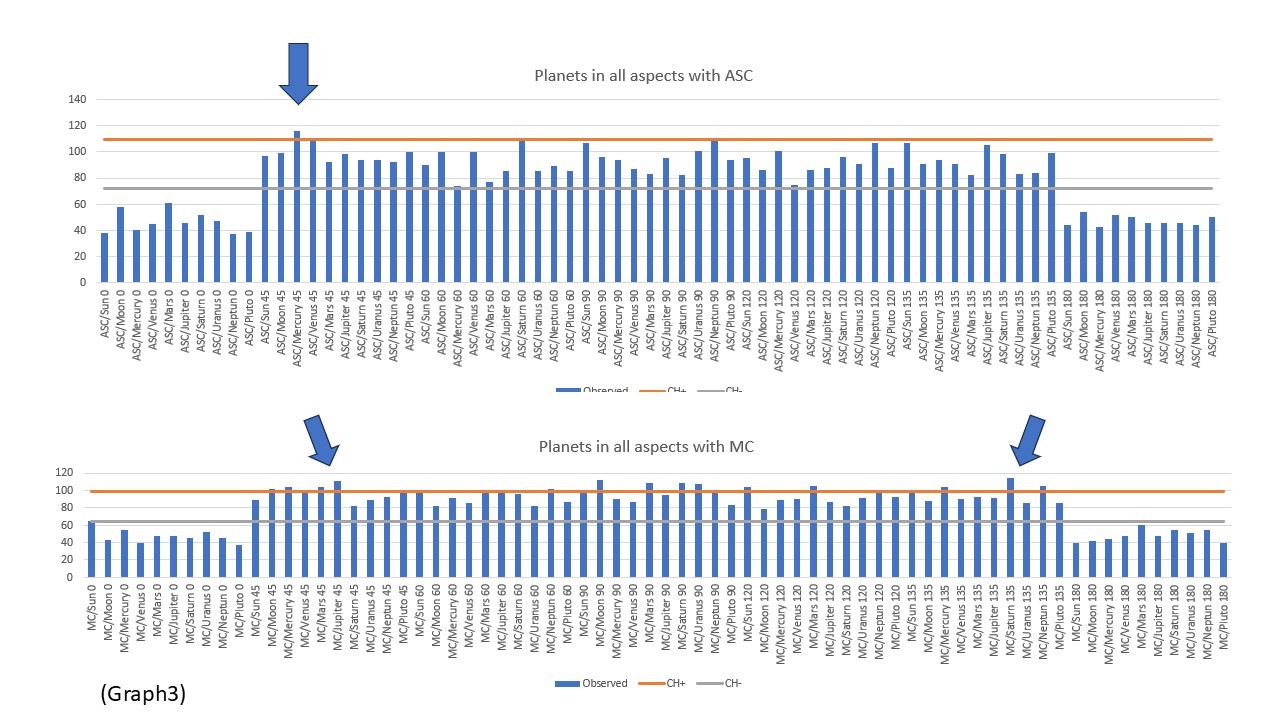
When considering planets in conjunction with the Lunar Nodes (NN), ASC, and MC, the interactions of Neptune with Uranus and Pluto, and the Saturn/Uranus aspects, maintain their hierarchical positions. Additionally, Mars's interactions with both MC and Pluto distinctly differentiate within the sample group (Table 5). All aspects between the planetary pairs listed in Table 5 were tested across different groups, and the results were found to be statistically significant (Table 6).
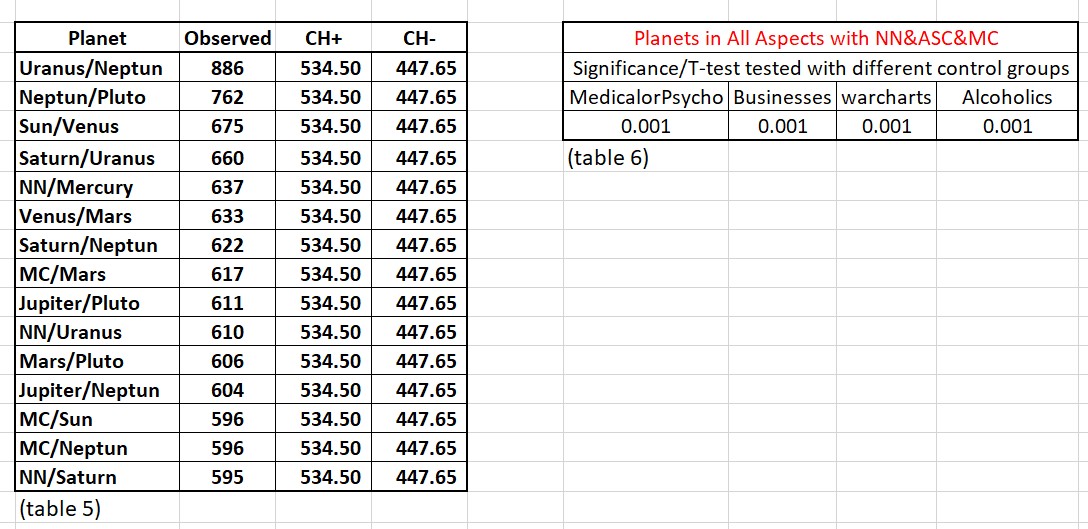
Planets and Asteroids
Asteroids, a relatively recent concept in astrological literature, entered the field starting in 1808. Their astrological application began with Eleanor Bach's publication of the first asteroid ephemeris in 1973. The initial four discovered asteroids – Ceres, Pallas, Juno, and Vesta (in order of discovery) – have recently gained more frequent use. The discovery of Chiron in 1977 led to the classification of Centaurs as a separate group.
When examining their influence on extraordinary natural events such as earthquakes, the interaction of Uranus/Pallas alongside Jupiter/Juno stands out in the data. This finding was also found to be statistically significant when compared across different groups (Table 7).
.jpg)
Since the first asteroid, Ceres, was not discovered until 1801, it is not possible to find references in early sources that associate these celestial bodies with earthquakes. However, symbolic or indirect connections can be established between the mythological figures after whom these asteroids are named and seismic events. In this context, Pallas and Juno are particularly noteworthy.
Although Pallas is not directly linked to earthquakes, in certain esoteric interpretations, she is seen as a symbol of cosmic explosions or destructive forces. According to mythological accounts, the birth of Pallas Athena—emerging fully armed from the head of her father, Zeus—is described as a profoundly violent and jarring event. While this may not indicate literal seismic activity, it can be interpreted as a form of symbolic or psychological upheaval.
Juno, on the other hand, is often portrayed as engaging in intense episodes of jealousy and power struggles with Zeus. These divine expressions of rage are, in some symbolic readings, seen as capable of disturbing or "shaking" the earthly realm, thus implying a metaphorical link to seismic phenomena.
Interestingly, the asteroid Juno is most often aspected by Jupiter, which is associated with Zeus.
Aries Point
The 0-degree Aries Point signifies the intersection of the ecliptic and the equator, representing the onset of spring. Symbolically, Earth is rejuvenated and prepares for a new cycle during the vernal equinox. In mythology, Persephone reunites with her mother Ceres during the spring equinox, ending Ceres' mourning and revitalizing the world.
The vernal equinox not only historically marks the beginning of a seasonal cycle but can also symbolize the dawn of an era, depending on its interaction with celestial bodies. Pluto is observed to form an aspect within a 1-degree orb with the 0-degree Aries Point, similar to its involvement in planetary combinations and interactions with angles (MC) (Graph 4).
.jpg)
Critical Degrees
Critical degrees are specific points within each zodiac sign believed to intensify astrological significance. These degrees are typically 0, 29, and sometimes 15 degrees, each possessing a unique energy associated with beginnings, endings, and heightened qualities or intensity. These sensitive degrees are linked to the three qualities of the zodiac. If a celestial body activates these degrees, it is likely to reveal specific challenges related to the corresponding sign. While these encounters may be difficult, they can offer significant new perspectives. Tragedies like earthquakes have sociologically and technically compelled humanity to transcend existing limitations.
The critical degrees are:
* 0, 13, 26 degrees for cardinal signs (Aries, Cancer, Libra, Capricorn)
* 8-9, 21-22 degrees for fixed signs (Taurus, Leo, Scorpio, Aquarius)
* 4 and 17 degrees for mutable signs (Gemini, Virgo, Sagittarius, Pisces)
Consistent with the zodiac sign distribution observed in the data, Capricorn and Pisces again appear prominent within the critical degrees. Specifically, 26 degrees of Capricorn (a cardinal sign) and 16 degrees of Pisces (a mutable sign) are encountered. This finding suggests a heightened association between earthquakes and the sign of Capricorn (Graph 5).
The distribution of the planets at these degrees is presented in the table below

However, when examining these same degrees in relation to the Ascendant and Midheaven (ASC/MC), mutable signs appear to be more prominent (Graph 6).

Moon Phases
Recently, like eclipses, lunar phases have been among the celestial events correlated with earthquakes.
A new study published in Seismological Research Letters by Susan Hough and her research group from the US Geological Survey examined 204 earthquakes with a magnitude of 8 or greater from 1600 to the present. The scientists' conclusion, based on their research findings, suggests that any perceived relationship between earthquakes and lunar phases or specific times of the year is entirely due to randomness or coincidence. According to the researchers, there is no specific reason behind the clustering of unrelated earthquakes on certain days. The maximum number of earthquakes occurring on a single day was 16, which coincided with 7 days after the New Moon phase. Statistically, it appears impossible to draw definitive conclusions linking lunar phases to major earthquakes with this data. However, the researchers also do not advocate for completely disregarding the relationship between lunar phases and major earthquakes.
According to the researchers, tidal stresses might trigger some earthquakes, but the contribution of tidal stresses is not significant enough to enable earthquake or tremor predictions. (12)
In 2016, two teams from the University of Tokyo analyzed earthquakes of magnitude 5 and above, focusing on the two weeks preceding them over the last 20 years. They noted that large earthquakes occurred close to the dates of the Full Moon and New Moon. Interestingly, the same study emphasized that no connection was found regarding smaller earthquakes. (13)
A 2003 study conducted in Taiwan also highlighted that no correlation was found between lunar phases and earthquakes above magnitude 5. (14)
An analysis of lunar phases in the 1687 earthquake chart revealed no significant differences. As shown in Graph 7, both the four main lunar phases and the eight detailed phases were analyzed separately. Neither graph shows a distinct difference. Although the Disseminating phase does not deviate significantly from the average, it shows a relative prominence compared to others. However, given that the phase leading up to the Full Moon was observed in 840 charts in the sample, and the Full Moon and subsequent phases were observed in 847 charts, it is not truly possible to draw definitive conclusions.
.jpg)
It is useful to recall a frequently used phrase by researchers: "If you flip a coin 5 times in a row, heads might come up 4 times. However, it would be incorrect to conclude from this that there is a high probability of getting heads every time the coin is tossed."
Midpoints
Midpoints represent the halfway point between two astrological points. All planets, NN, ASC, and MC were individually analyzed at planetary midpoints and aspects to these midpoints. (e.g., Uranus aspect (0, 45, 60, 90, 120, 135, 180) Jupiter/Pluto midpoint) (Table 8).
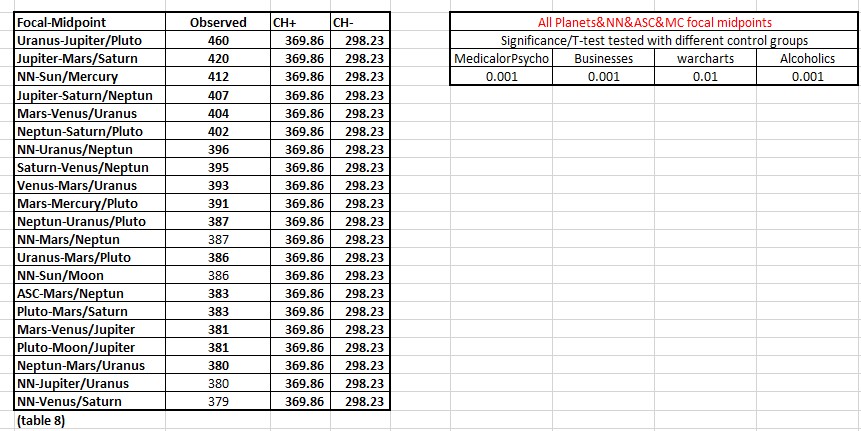
When the Vx and Ep were analyzed, no significant difference was observed in the aspects formed by Vx and Ep to planetary midpoints.
Fixed Stars
Everything in the universe is in constant motion. The term "fixed stars" in astrology is a misnomer, arising from the seemingly motionless appearance of stars that are not part of our solar system, in contrast to the movements of planets, asteroids, the Sun, and the Moon, which are traditionally used parameters in astrology and divided into astrological houses. In reality, fixed stars shift approximately one degree every 72 years. Ancient astrologers believed that the most significant observable stars had a specific influence if they were in close relation to the planets or angles of a birth chart.
When examining the conjunctions of fixed stars within a 2-degree orb with planets, TNOs, asteroids, Vx, Ep, ASC, and MC, the most prominent fixed stars observed were Alhena and Gemma. Other significant fixed stars are listed in Table 9 in descending order of prominence.
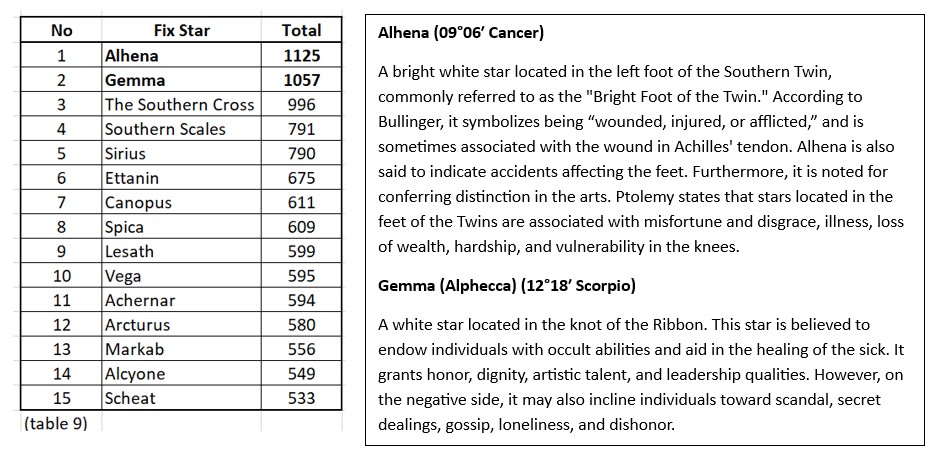
Alhena was most frequently observed in the sample with the North Node, following Kronos and Hades. Gemma was observed with Juno and Jupiter, following Poseidon. The distribution of fixed stars in relation to planets is presented in Table 10.
.jpg)
From the perspective of planetary aspects to fixed stars, Vega and Achernar stand out as particularly significant due to the frequency and strength of their alignments. Vega, associated with refinement, idealism, and artistic flair, often reflects a dignified yet sensually oriented nature. Achernar, on the other hand, symbolizes intellectual pursuit, authority, and transformation—though traditionally linked with maritime hazards. Their recurrent involvement in key planetary configurations may point to an elevated symbolic resonance in the astrological signatures observed. (Table 11)
.jpg)
OOB Planets
A planet is defined as "out of bounds" (OOB) when its declination exceeds 23°28′ North or South. Each planet moves along the ecliptic, and when it moves outside the ecliptic's inclination to the equatorial circle, it allows us to attribute an unusual significance to that planet. In this context, OOB planets can be considered to possess extraordinary characteristics. In our sample group of 1687 earthquake charts, Mars was conspicuously observed among OOB planets, followed by Mercury, the Moon, and Venus. When this result was tested with different groups, a significant result was only obtained with the business group (with a value of 0.5), while other groups did not show a significant correlation. Therefore, it does not appear possible to state that there is a significant connection related to OOB planets (Graph 8).
.jpg)
Aspect Patterns
Aspect patterns refer to specific geometric configurations formed by planets in a chart:
* Grand Trine: An aspect pattern formed by three planets making 120-degree aspect to each other.
* T-Square: An aspect pattern formed when two planets are in opposition, and a third planet forms a square to both.
* Grand Cross: An aspect pattern formed by four different planets making square aspects to each other.
Among the observed aspect patterns within the sample, a Grand Trine involving Mercury-Jupiter-Pluto was identified. (Table 12)

Initially, only aspect patterns formed by planets were investigated. Subsequently, TNOs, asteroids, ASC, and MC were included to examine how the distribution changed. The highly stressful Grand Cross aspect pattern was rarely observed, even when examined with a wide orb (8 orb).
Moreover, when this result is compared across distinct groups, it demonstrates statistical significance. (13)
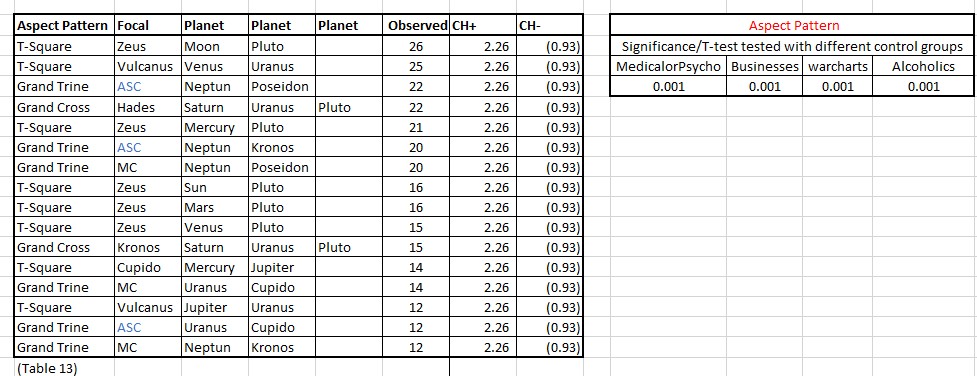
Conclusion
In light of all these findings, it can be concluded that Pluto consistently appears as the most prominent planetary body across various combinations. Whether in aspects formed between planets themselves or in configurations involving Trans-Neptunian Planets (TNPs), Pluto emerges as a dominant figure. Its prominence is not limited to aspects alone; Pluto also stands out in aspect patterns, in midpoint combinations, the 0° Aries point, in relation to fixed stars, and within sensitive degrees, marking it as a key finding across the dataset.
Given Pluto's status as a slow-moving planet and the historical range of the sample group, its frequent appearance under various categories may be considered expected to some extent. However, its significance becomes more notable when considering aspect patterns, midpoint combinations, and connections with angular points.
As previously discussed, Ptolemy's interpretation regarding earthquakes emphasized the placement of Saturn and Mars in Earth signs. This research appears to support that perspective: Saturn's predominance in Capricorn aligns with Ptolemy’s view, while Mars is most frequently observed along the Gemini–Sagittarius axis.
Furthermore, although traditional interpretations of Uranus in relation to the meridian (MC) do not directly conflict with the present findings, Uranus still appears among the planets forming aspects with the Midheaven (MC). In order, Saturn forms a 135° aspect, the Moon a 90° aspect, and Jupiter a 45° aspect to the MC. Uranus and Mars are also among the top ten planets for MC aspects. As for the Ascendant (ASC), it is most frequently activated by semi-square aspects from fast-moving planets. (see Table 14)
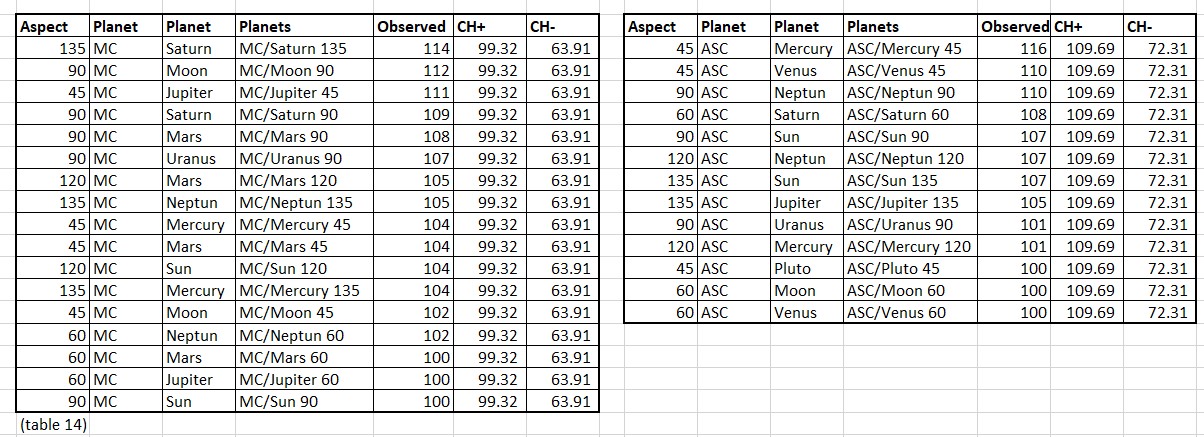
All findings were collated under the final astro signature and tested in all sample groups.

All prominent findings were consolidated under a single astro-signature and tested on the charts of 13 earthquakes of magnitude 6.0 or higher that occurred in March and July 2025, which were not part of the original sample. Among the findings, the slow-moving planets (Saturn, Uranus, Neptune, and Pluto) are observed to be in simultaneous interaction with each other. Additionally, the lunar nodes are found to be interacting both with planets and planetary midpoints. This suggests that the connection between the Moon and the Sun cannot be overlooked in relation to earthquakes. Among the fast-moving planets, Mars—through its interactions with both other planets and the Midheaven (MC)—may also be a factor that warrants close observation in the context of earthquakes (Table 15).
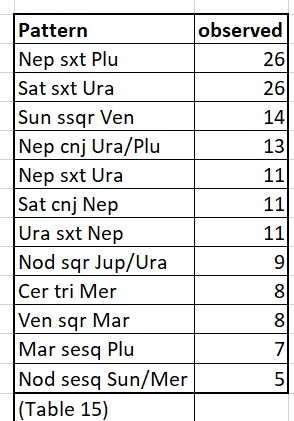
(1)Arınma ritüellerinin bütününü kapsayan Namburbi Ritüelleri’nin metin ve içerikleri hakkında ayrıntılı bilgi için bkz.(Çeçen, Gökçek, Akyüz2020, s. 159)
(2) Agizza, R., 2001. Antik yunanda mitoloji. Çeviren; Zühre, Z., Arkeoloji ve Sanat Yay., İstanbul, 18 s.
(3) Kranz, W., 1984. Antik Felsefe, Çeviren; Baydur, S, Y., Sosyan Yay., İstanbul, 29 s.
(4) O’Grady, P, F., 2002. Thales of Miletus The Beginnings of Western Science and Philosophy, Routledge, New York, USA, 131 – 132 s.
(5) Ben-Menahem, A., 2006. A Concise History of Mainstream Seismology: Origins, Legacy and Perspectives, Bulletin of the Seismological Society of America, Vol. 85, No. 4, 1206 s.
(6) Şahin, Övünç, 2019, Mavi Gezegen, 27 s
(7) Aristoteles, 2012. Phıloponus On Aristotle
Meteorology 1.4-9, 12, Translated; Kupreeva, I., Bloomsbury, London, UK, 84 s.
(8) Aristoteles, 2012. Phıloponus On Aristotle
Meteorology 1.4-9, 12, Translated; Kup
(9) Ptolomy, Tetrabiblos, book II, (11. Of the Nature of the Signs, Part by Part,
and their Effect upon the Weather.)
(10) Ptolomy, Tetrabiblos, book IV, Chapter 8, Pg 197
(11) R. TOMASCHEK, 1959 Nature Publishing Group
(12) 2023, 18 February, Biamag, Durakcan Yusuf Cem
(13) 2016,13 September, Sience Alert, Peter Dockrill
(14) October 2003 Terrestrial Atmospheric and Oceanic Sciences14(3):1-10
(15) Fixed Stars and Constellations in Astrology, Vivian E. Robson, 1923, p.46, 126-127
(16) Fixed Stars and Judicial Astrology, George Noonan, 1990, p.14.